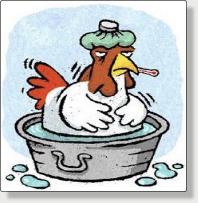Slow Practice Ain’t Chicken Soup |
||
By itself, however, “slow down” doesn’t tell us much. When we’re doing something wrong, slowing down is only part of the solution. What do we do once we’ve slowed down? If we don’t know, we might keep doing the wrong thing we did when playing faster. After all, bad practice slowed down is just slower bad practice. And if we don’t know the crucx of effective practice, then we don’t know how slow to go or how gradually to speed up. First things first: effective practice isn’t the result of slowing down—rather, slowing down is the inevitable consequence of effective practice. To explain further, let’s look at some obvious characteristics of good practice:
These steps are familiar to anyone who takes practice seriously. And we could have 100 different guitarists carry out all these steps. Each guitarist would assert that he or she is doing what needs to be done. Yet inevitably, maybe one out of 100 will eventually play at a very high level. The rest will fall short. Why? The likely answer is that although all guitarists can go through the same steps, not all carry out the steps with sufficient rigor. Most of us move to the next step before thoroughly mastering the previous step. We can’t help it. We’re impatient. Time is short. We want so badly to already be there. So we cut corners. We don’t mean to, and we never realize we’re cutting corners. But we are. And it shows in our playing. The one person out of 100 who plays at a high level is the one who stayed with each step until he or she had it down cold. This one person demanded perfection. (If I can’t do it five times in a row without error, then I’m not ready to move on.) This one person practiced consistently, seldom allowing a day to go by without working at whatever was the problem at hand. This one person at all times did every step as if onstage, in front of a discerning audience. This one person knew that a hint of indecision or nervousness in the practice room will be exponentially magnified onstage. This one person understood the immense power of slow but sure incremental improvement. Slow practice isn’t the crux. It’s a consequence of the crux. The crux of effective practice is this: accept nothing less than perfection. And who are those who dismiss perfection as pie in the sky? Well, that would be me and everyone else who’s not a virtuoso. We’re the “sensible” ones. We “know” that perfection is an impossible dream. So we putter along, vaguely hoping we’ll get better without embracing the exacting standards of the virtuoso. Fortunately, however, we don’t have to be permanent members of the mediocrity cult. (I don’t want to stay there. Do you?) We can at any time cross over to the rarified ranks of the virtuoso practicer. We just have to tire, at long last, of cutting corners. Once there, we may not rise to the heights of those who made that decision at a tender age. But we may catch a glimpse of the promised land. To download a PDF of this article, click here.
|
||
 “
“